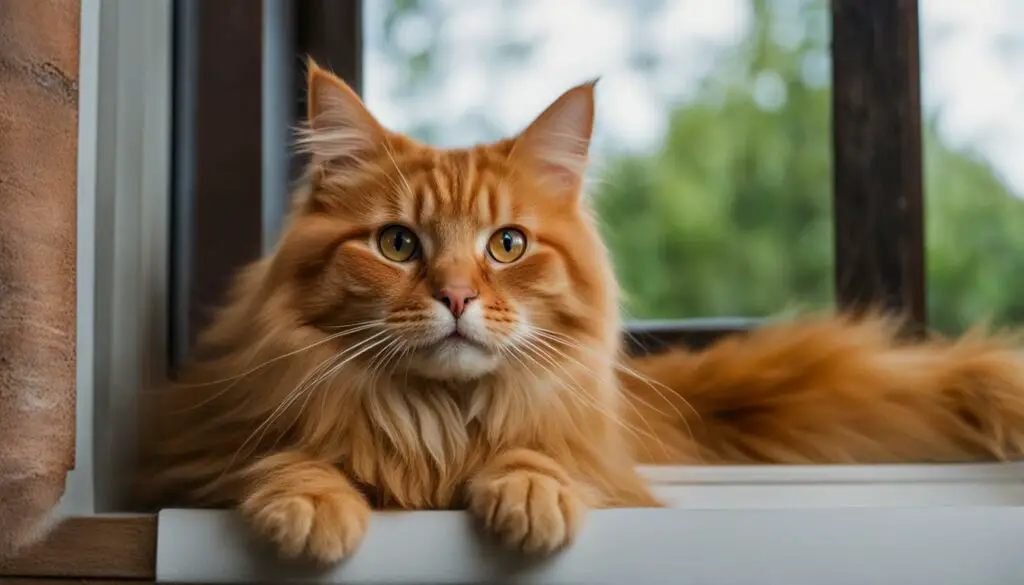As a cat owner, I often find myself wondering why my feline friend is so demanding and talkative. Cats are known for their independent nature, so it can be perplexing when they exhibit clingy and vocal behavior. To better understand why cats behave this way, it’s important to delve into the reasons behind their attention-seeking tendencies, demanding meows, and constant desire for communication.
Cats can be affectionate and loving creatures, but their neediness and vocalization may stem from various factors. It’s crucial to remember that every cat is unique, and what may apply to one may not necessarily apply to another. However, by understanding some common reasons for needy and vocal behavior, we can work towards addressing these behaviors and creating a harmonious relationship with our feline companions.
Key Takeaways:
- Cats can exhibit needy and vocal behavior for various reasons, including health issues, accidental reinforcement, and a lack of guidance and training.
- Health issues can contribute to clingy behavior in cats, so it’s important to schedule regular vet visits to rule out any underlying medical problems.
- Unintentionally reinforcing clingy behaviors can make them more prominent, so it’s crucial to identify and address accidental reinforcement.
- Adult cats that have not received proper guidance and training may exhibit clingy behaviors that can be modified through positive reinforcement training.
- By redirecting behavior and providing positive reinforcement, we can reduce a cat’s clinginess and encourage independence.
Health Issues as a Cause of Needy Behavior
Cats can display needy behavior due to various health issues that may affect their overall well-being. It is important to consider the possibility of medical problems when addressing a cat’s clinginess and vocalization. Here are some common health issues that can contribute to needy behavior in cats:
- Urinary tract infections: Cats with urinary tract infections may exhibit increased clinginess and vocalization as they experience discomfort and pain.
- Arthritis: Older cats with arthritis may seek extra attention and become clingy due to joint pain and stiffness.
- Anxiety and stress: Cats experiencing anxiety or stress may exhibit clingy behavior as a way to seek comfort and reassurance from their owners.
- Hyperthyroidism: Cats with an overactive thyroid gland may display increased neediness and vocalization as a result of hormonal imbalances.
| Health Issue | Signs and Symptoms | Treatment Options |
|---|---|---|
| Urinary tract infections | Frequent urination, straining to urinate, blood in urine | Antibiotics, increased water intake, dietary changes |
| Arthritis | Limping, reluctance to jump or climb, decreased mobility | Pain medication, joint supplements, environmental modifications |
| Anxiety and stress | Excessive grooming, hiding, aggression, litter box issues | Behavioral modification, environmental enrichment, anti-anxiety medications if necessary |
| Hyperthyroidism | Weight loss, increased appetite, restlessness | Medication, radioactive iodine therapy, dietary changes |
If you suspect that your cat’s clingy behavior is due to a health issue, it is crucial to consult with a veterinarian. A thorough examination and appropriate diagnostic tests can help identify and treat any underlying medical problems. Addressing the health issues can contribute to a reduction in clingy and vocal behaviors.
In the next section, we will explore how accidental reinforcement of needy behaviors can contribute to a cat’s clinginess and vocalization.

Accidental Reinforcement of Needy Behaviors
Needy behaviors in cats, such as excessive meowing and constant cuddling, can sometimes be inadvertently reinforced by well-meaning cat owners. When a cat’s attention-seeking behaviors are accidentally reinforced, they may continue and even escalate over time. It’s important for cat owners to recognize and address these unintentional reinforcements in order to modify and reduce clingy behavior.
One common way that cat owners accidentally reinforce needy behaviors is by providing immediate attention or affection in response to their cat’s demands. For example, if a cat meows persistently for attention and their owner consistently responds by petting or cuddling them, the cat learns that meowing leads to the desired outcome. This accidental reinforcement strengthens the connection between meowing and receiving attention, encouraging the cat to continue this behavior.
To break this cycle, cat owners can employ strategies that redirect the cat’s behavior and reinforce more desirable actions. For instance, instead of responding immediately to meowing, owners can wait until the cat is quiet before providing attention or affection. This communicates to the cat that quiet behavior is more likely to result in attention, encouraging them to gradually reduce their meowing over time.
| Accidental Reinforcement of Needy Behaviors | Impact | Solution |
|---|---|---|
| Immediate attention and affection in response to meowing | Reinforces meowing behavior, encouraging the cat to continue | Wait for quiet behavior before providing attention, reinforcing calmness |
| Consistent rewards for clingy behavior | Strengthens the association between clinginess and positive outcomes | Encourage independence by rewarding moments of solitude or self-play |
| Allowing access to desired resources upon demand | Encourages demanding behavior as a means to obtain desired resources | Implement scheduled feeding and playtimes, gradually reducing immediate access to resources upon demand |
Train your cat to understand that calm behavior is more likely to result in attention and rewards.
In addition to unintentional reinforcement, cat owners may inadvertently encourage clingy behavior by providing constant access to desired resources upon demand. For example, if a cat meows persistently to be fed and their owner immediately fills their food bowl, the cat learns that meowing leads to getting their way. This reinforces the demanding behavior and can contribute to increased clinginess.
To address this, cat owners can implement scheduled feeding and playtimes, gradually reducing immediate access to resources upon demand. This helps the cat understand that their needs will be met, but not always immediately. By establishing a routine, cats can learn to wait patiently, reducing their dependence on immediate gratification.
Addressing Accidental Reinforcements:
- Wait for quiet behavior before providing attention, reinforcing calmness.
- Encourage independence by rewarding moments of solitude or self-play.
- Implement scheduled feeding and playtimes, gradually reducing immediate access to resources upon demand.
Lack of Prior Guidance and Training
When it comes to understanding why adult cats exhibit needy behaviors, one important factor to consider is the lack of prior guidance and training. Cats, like any other pet, require proper training and socialization to develop appropriate behavior patterns. Unfortunately, some cats may not have received this guidance during their formative years, leading to clingy and vocal behavior.
The absence of proper training can result in cats developing behaviors that are overlooked or even encouraged by their owners. For example, if a cat receives attention or food every time they meow excessively, they may continue this behavior as a way to get their needs met. Similarly, if a cat has not been taught alternative ways to seek attention or engage in activities, they may resort to clingy behavior as their only means of interaction.
However, it’s never too late to address and modify these behaviors through positive reinforcement training. By teaching cats alternative behaviors and rewarding them for displaying desired actions, owners can gradually guide their pets towards more independent and balanced behavior patterns. With patience and consistency, adult cats can learn new ways to seek attention and engage in activities that do not rely solely on clingy and vocal behavior.

Table: Training Tips for Addressing Clingy Behavior
| Training Tips | Description |
|---|---|
| Positive Reinforcement | Reward cats for displaying desired behavior, such as using a scratching post instead of clinging to furniture. |
| Redirecting Attention | Provide stimulating toys and activities to redirect the cat’s focus away from clingy behavior. |
| Creating a Safe Space | Designate a specific area or room where the cat can retreat to when they need some alone time. |
| Establishing a Routine | Maintain a consistent schedule for feeding, playtime, and grooming to help cats feel secure and confident. |
Training Tips for Laptop Lovers
If you find that your cat is constantly interrupting your work on the laptop, there are some effective training techniques you can use to redirect their behavior. By using positive reinforcement, you can teach your feline friend alternative ways to seek attention and reduce their neediness.

Redirect Behavior
One way to discourage your cat from jumping on the laptop is to catch them in the act and gently stomp your foot to interrupt their behavior. This sends a clear message that the laptop is off-limits. It’s important to be consistent and respond every time your cat tries to approach the table.
Provide Alternative Resting Spaces with Rewards
To redirect your cat’s attention away from the laptop, create alternative resting spaces that are equally comfortable and appealing. This could be a cozy pet bed or a designated area with a soft blanket. Encourage your cat to use these spaces by providing rewards such as treats or playtime when they choose to rest there instead of on your laptop.
By implementing these training tips, you can help your laptop-loving cat understand boundaries and reduce their need to constantly seek attention while you work.
Training Tips for Chatty Catties
Does your cat meow incessantly for attention? Are you looking for ways to reduce their vocalization and attention-seeking behavior? With positive reinforcement training techniques, you can help redirect your chatty catty’s behavior and promote more desirable habits.
Understanding Vocalization
Before diving into training tips, it’s essential to understand why cats vocalize. Meowing is a form of communication, and excessive vocalization may indicate boredom, hunger, or a need for attention. By acknowledging their vocalizations and providing alternative methods of communication, you can help reduce their dependency on constant meowing.
Stomping and Rewarding
One effective training technique is to stomp your foot lightly when your cat meows excessively. This action serves as a gentle interruption, signaling that meowing is not the desired behavior. Once your cat stops meowing, reward them with treats or praise to reinforce the desired behavior. Over time, they will associate silence with positive rewards.
Additionally, you can teach your cat alternative behaviors to seek attention. For example, you can train them to come to you for a treat or engage in interactive play with toys. This redirection of attention helps shift their focus away from excessive vocalization and encourages them to engage in more appropriate behaviors.
| Training Tips for Chatty Catties | Summary |
|---|---|
| Understand vocalization | Recognize that excessive meowing is a form of communication and address underlying needs. |
| Stomp and reward | Interrupt excessive meowing by stomping your foot and reward moments of silence with treats or praise. |
| Teach alternative behaviors | Train your cat to seek attention through alternative behaviors, such as coming to you for a treat or engaging in interactive play. |
Remember, training takes time and patience. Consistency is key to achieving lasting results. By utilizing these training tips, you can help your chatty catty develop more balanced behaviors and create a harmonious environment for both you and your feline companion.
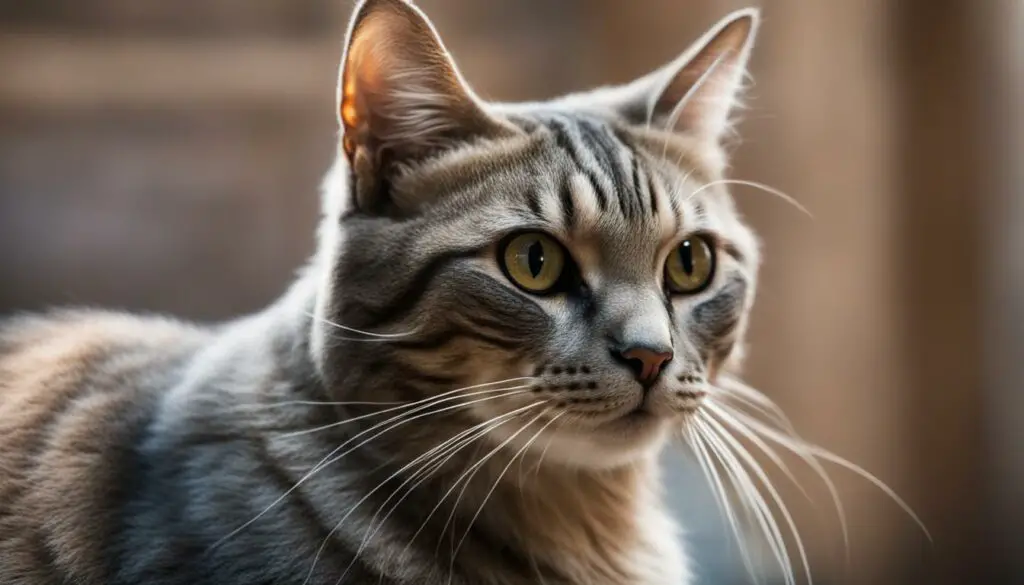
Training Tips for Feline-Shaped Shadows
Does your cat constantly follow you around, making it difficult to get things done? If your feline companion has become a shadow that never leaves your side, there are training techniques you can use to encourage independence and reduce their clinginess. Here are some tips:
1. Redirecting Behavior with Interactive Toys
One effective way to distract your cat from attaching to your legs is by providing interactive toys. Toys like feather wands or small plastic balls can capture your cat’s attention and engage them in playful activities. This can redirect their focus away from following you and encourage them to explore and entertain themselves.
2. Establishing Boundaries
Setting boundaries and creating designated spaces for your cat can help reduce their need to constantly follow you. Designate a cozy corner or a comfortable bed for them, complete with their favorite toys and blankets. Encourage them to spend time in their own space by offering treats and rewards. Gradually, they will learn to enjoy their independence while still feeling secure in their own special area.
3. Providing Mental Stimulation
Cats that become overly attached may benefit from increased mental stimulation. Offer puzzle toys or treat-dispensing toys that require problem-solving skills. This can keep them mentally engaged and entertained, helping to divert their attention away from following you and onto more stimulating activities.

4. Encouraging Positive Behaviors
Rewarding desirable behaviors can be a powerful way to shape your cat’s actions. When your cat chooses to stay in their designated area or engages in independent play, praise them and offer their favorite treats as positive reinforcement. This will help reinforce their independence and reduce their clinginess over time.
Remember, training takes time and patience. Be consistent with your efforts and provide plenty of love and attention to your cat. By implementing these training tips, you can help your feline friend become less clingy and develop a healthier sense of independence.
Signs of a Clingy Cat
Clingy cats can display certain behaviors that indicate their need for attention and constant proximity to their owners. These signs may vary from cat to cat, but they generally include:
- Following their owners everywhere, even to the bathroom
- Becoming anxious or upset when left alone
- Getting jealous when attention is given to other pets or people
- Always wanting to be near their owners, often sitting on their laps or following them closely
These signs of clingy behavior may seem endearing at first, but they can become overwhelming and disruptive to both the cat and their owner’s daily life. It’s important to recognize these signs and address them to help promote a healthier and more balanced relationship with your cat.
Understanding the reasons behind clingy behavior is essential for effectively managing it. Cats may become clingy due to a variety of factors, such as a lack of socialization, anxiety or stress, boredom, illness, early trauma, or simply a natural need for attention. By identifying the underlying cause, you can tailor your approach to reducing your cat’s clinginess effectively.
Addressing Clinginess through Positive Reinforcement
One way to manage clingy behavior is through positive reinforcement training. By rewarding your cat for independent behavior and gradually encouraging their self-reliance, you can help them become more comfortable being alone and less reliant on constant attention. Additionally, providing mental and physical stimulation, such as interactive toys and play sessions, can help alleviate boredom and redirect their focus away from clingy behaviors.
Creating a safe and secure environment for your cat is also important. By designating a comfortable space with cozy bedding, toys, and scratching posts, you can give your cat a place of their own to retreat to when they need some alone time. This can help reduce their need to constantly seek out your attention.
| Signs of a Clingy Cat | How to Address Clinginess |
|---|---|
| Following their owners everywhere | Positive reinforcement training |
| Becoming anxious or upset when left alone | Creating a safe and secure environment |
| Getting jealous when attention is given to other pets or people | Providing mental and physical stimulation |
| Always wanting to be near their owners | Designating a comfortable space for them |
By understanding the signs of clingy behavior and implementing appropriate strategies to address it, you can help your cat become more independent and build a healthier bond with them.
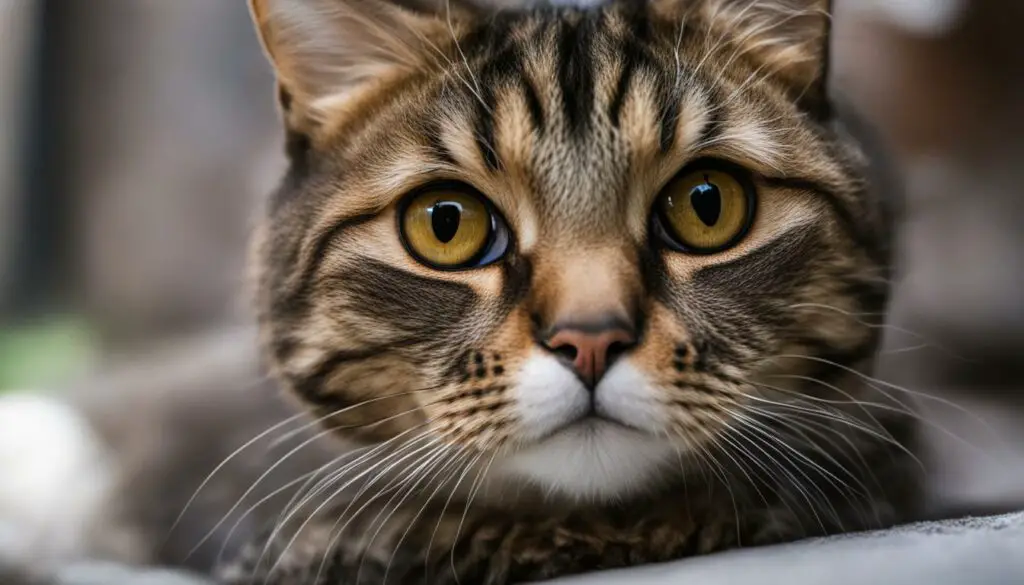
Reasons for Clingy Cat Behavior
Cats can display clingy behavior for various reasons, which can include a lack of socialization, anxiety, and boredom. Understanding these reasons can help you address and manage your cat’s clinginess effectively.
Lack of Socialization: Cats that have not been adequately socialized may feel anxious and insecure, leading to clingy behavior. Socialization involves exposing cats to different people, animals, and environments from a young age, helping them feel more confident and comfortable in various situations.
Anxiety: Cats can experience anxiety due to changes in their environment, such as moving to a new home or the addition of new family members or pets. This anxiety can manifest as clingy behavior as cats seek comfort and reassurance from their owners.
Boredom: Cats that are bored or understimulated may exhibit clingy behavior as a way to seek attention and entertainment. Providing your cat with plenty of mental and physical stimulation through interactive toys, puzzle feeders, and playtime can help alleviate boredom and reduce clinginess.
| Reasons for Clingy Cat Behavior | Description |
|---|---|
| Lack of Socialization | Cats that have not been adequately socialized may feel anxious and insecure, leading to clingy behavior. |
| Anxiety | Cats can experience anxiety due to changes in their environment, such as moving to a new home or the addition of new family members or pets. |
| Boredom | Cats that are bored or understimulated may exhibit clingy behavior as a way to seek attention and entertainment. |
Addressing Clingy Behavior
To address your cat’s clingy behavior, consider the following tips:
- Gradual desensitization: Gradually expose your cat to situations that may trigger clinginess, allowing them to become more comfortable and confident over time.
- Provide environmental enrichment: Offer a variety of toys, scratching posts, and hiding spots to keep your cat mentally and physically stimulated. This can help alleviate boredom and reduce clingy behavior.
- Establish a routine: Cats thrive on routine, so create a consistent schedule for feeding, playtime, and affection. This can help provide a sense of security and minimize anxiety-related clingy behavior.
- Seek professional help if needed: If your cat’s clinginess becomes excessive or persistent despite your efforts, it may be beneficial to consult a veterinarian or animal behaviorist for further guidance and support.
By understanding the reasons behind your cat’s clingy behavior and implementing appropriate strategies, you can help your cat feel more secure and content while fostering a balanced and loving bond.
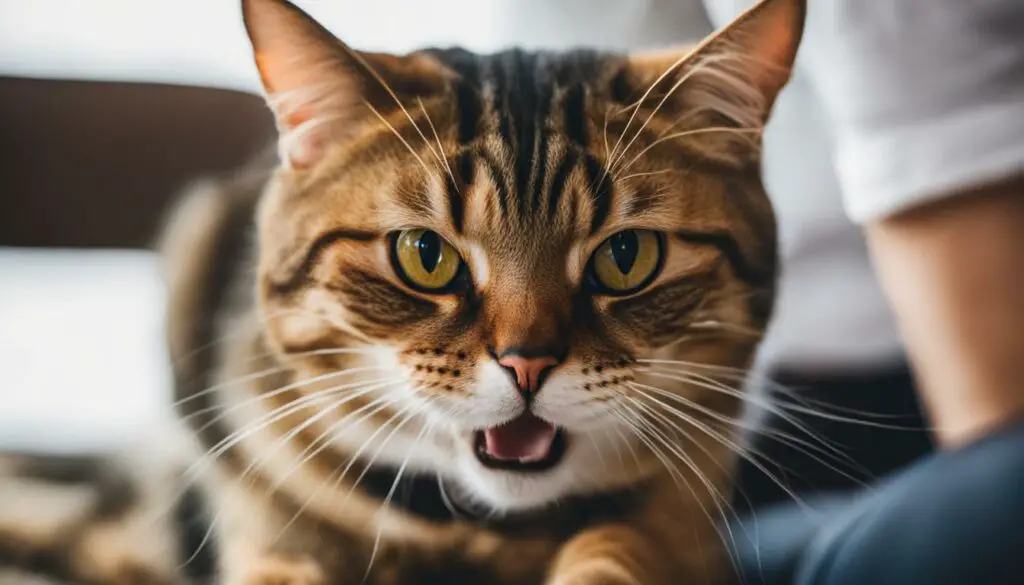
How to Reduce Your Cat’s Clinginess
If your cat tends to be overly clingy and dependent, there are several strategies you can employ to help reduce their clinginess and encourage independence.
Attention in Moderation
While it’s important to show your cat love and affection, providing attention in moderation can help prevent them from becoming overly needy. Set aside dedicated play and cuddle sessions throughout the day, but also encourage independent playtime with interactive toys. This will help them learn to enjoy their own company and reduce their constant need for attention.
Encourage Independence
Gradually detaching your cat from constant proximity to you can help foster their independence. Create an environment that offers various cozy spots for them to rest and relax, such as cat trees, perches, and comfortable beds. Reward them when they choose these spots on their own, reinforcing the positive behavior of independent lounging.
Mental and Physical Stimulation
Engaging your cat in mentally and physically stimulating activities can help keep them occupied and prevent clingy behavior. Provide puzzle toys filled with treats, interactive feeding toys, and playtime with wand toys or laser pointers to keep them mentally and physically active. This will help distract them from seeking constant attention and satisfy their need for stimulation.
By implementing these strategies, you can help reduce your cat’s clinginess and promote a healthier balance of attention and independence in their behavior.
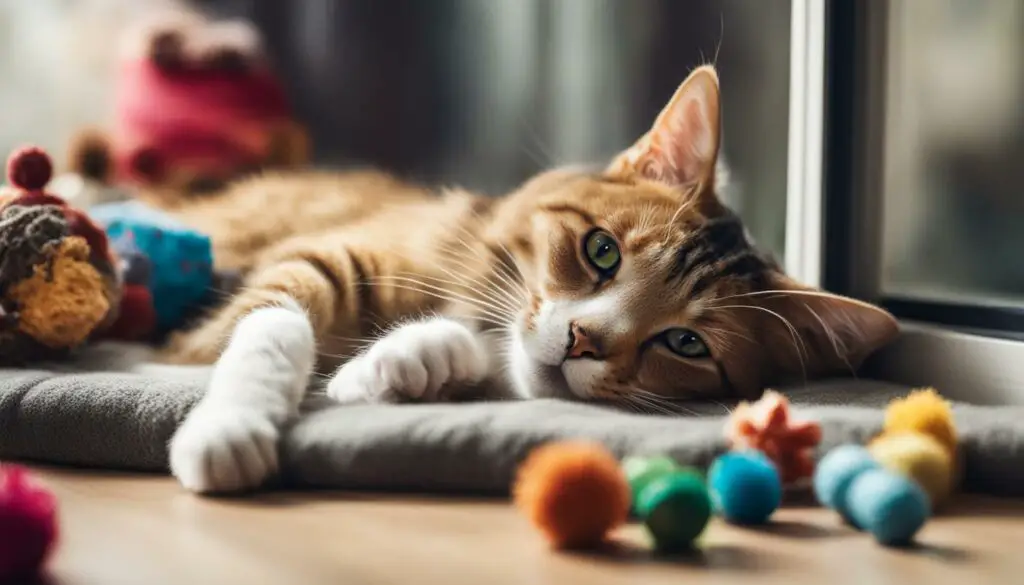
Why Is My Cat So Affectionate All of a Sudden?
It’s not uncommon for cats to exhibit sudden displays of affection. There can be various reasons behind this behavior, including attention-seeking, hormonal changes, and getting older. Cats are known for their independent nature, but they also crave companionship and interaction with their human counterparts. When they feel the need for attention, they may become more affectionate, seeking physical contact and closeness.
One possible reason for sudden affection is attention-seeking behavior. Cats are highly perceptive creatures and can sense when their owners are not focused on them. They may resort to affectionate gestures to grab their owner’s attention and regain the spotlight. By rubbing against your legs, purring, or gently nudging you, they are reminding you of their presence and desire for interaction.
Hormonal changes can also play a role in your cat’s sudden display of affection. Female cats may become more affectionate during their heat cycles or pregnancy. These hormonal changes can increase their need for comfort and closeness, as well as their desire to bond with their owners. Likewise, as cats age, they may experience changes in their hormone levels, which can influence their behavior and make them more inclined to seek affection.
It’s important to note that sudden displays of affection can also be influenced by individual personality traits and preferences. Some cats are naturally more affectionate than others, and their behavior may vary based on their unique disposition. Understanding your cat’s personality and taking note of their behavior patterns can help you better interpret their sudden displays of affection.
| Reasons for Sudden Affection | Examples |
|---|---|
| Hormonal Changes | Heat cycles, pregnancy, age-related hormone fluctuations |
| Attention-Seeking | Rubbing against legs, purring, nudging |
| Individual Personality Traits | Naturally affectionate disposition |
Remember, every cat is unique, and their behavior can be influenced by various factors. If your cat suddenly becomes more affectionate, it’s a sign that they value your companionship and trust you. Embrace their affection and reciprocate with gentle petting and quality time together. Building a strong bond with your cat can further enhance their affectionate nature and strengthen your relationship.
Why Is My Cat Being So Clingy and Vocal?
It can be concerning when our cats exhibit clingy and vocal behavior. Understanding the reasons behind these behaviors is crucial for effectively managing and addressing them. Cats can be attention-seeking creatures, and their neediness may stem from various factors such as hunger, medical issues, age-related changes, and breed characteristics.
Cats that are attention-seeking may display clingy and vocal behavior as a way to communicate their needs and desires. They may meow incessantly or follow their owners around, seeking attention and interaction. This behavior can be intensified if the cat’s basic needs, such as food and water, are not met. Ensuring that your cat is well-fed and has access to fresh water can help alleviate their clinginess.
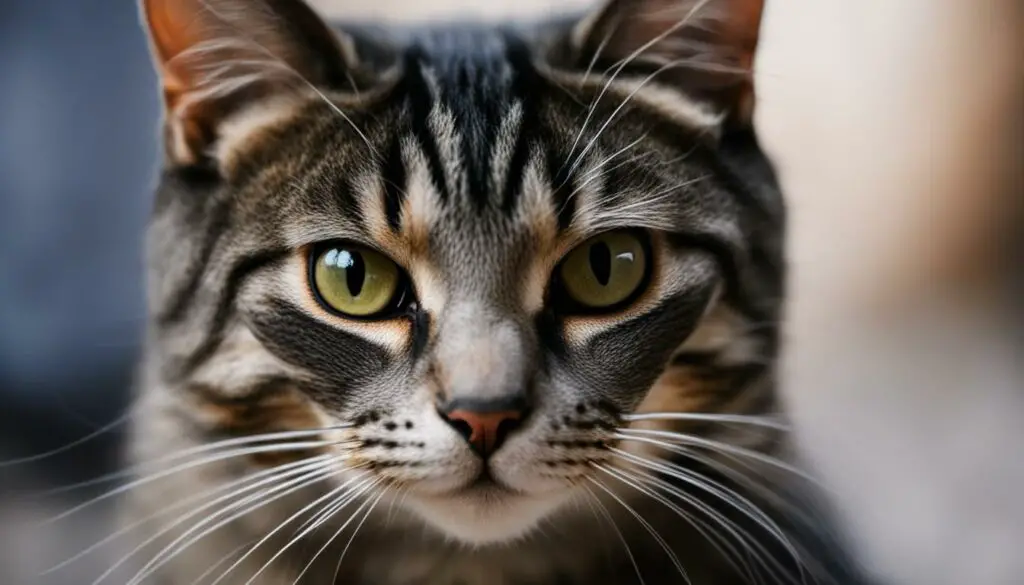
Medical issues can also contribute to clingy and vocal behavior in cats. If your cat suddenly becomes excessively clingy or vocal, it is essential to rule out any underlying medical conditions by consulting with a veterinarian. Cats may exhibit these behaviors as a way to communicate pain, discomfort, or other health-related concerns.
Another factor to consider is the age and breed of your cat. Older cats may become more dependent and clingy due to age-related changes, such as cognitive decline or arthritis. Certain breeds, such as Siamese cats, are known for their vocal nature and may exhibit more clingy behavior as a result.
Table: Common Factors Contributing to Clingy and Vocal Behavior in Cats
| Factors | Description |
|---|---|
| Attention-seeking | Cats may exhibit clingy and vocal behavior to seek attention and interaction from their owners. |
| Hunger | If a cat’s basic needs for food and water are not met, they may become clingy and vocal. |
| Medical issues | Underlying medical conditions can cause cats to display clingy and vocal behavior. |
| Age-related changes | As cats age, they may become more dependent and exhibit clinginess. |
| Breed characteristics | Certain cat breeds, such as Siamese cats, are known for their vocal nature and may exhibit clingy behavior. |
Understanding the underlying factors contributing to your cat’s clingy and vocal behavior is important for providing appropriate care and addressing their needs. By addressing any potential hunger or medical issues and providing your cat with the attention and interaction they require, you can help reduce their clinginess and create a harmonious relationship with your feline friend.
Conclusion
In conclusion, understanding and managing clingy and vocal behavior in cats is essential for maintaining a harmonious relationship with our feline companions. By recognizing the underlying factors that contribute to these behaviors, such as health issues, accidental reinforcement, and a lack of guidance and training, we can take appropriate steps to address them effectively.
When it comes to health issues, seeking veterinary advice is crucial. By ruling out any underlying medical problems, we can ensure that our cats receive the necessary treatment and alleviate any behavior changes caused by discomfort or pain.
Accidental reinforcement of needy behaviors can be addressed through awareness and consistency in our interactions with our cats. By avoiding unintentional rewards for clingy behavior and rewarding desired behaviors instead, we can help modify and reduce their neediness over time.
Training and positive reinforcement play a crucial role in managing clingy and vocal behavior.
Lack of guidance and training can contribute to clinginess in adult cats. However, it is never too late to start training and provide them with the necessary tools to become more independent. Through positive reinforcement techniques, we can redirect their behavior and encourage alternative, more desirable behaviors.
In conclusion, by reducing excessive attention, encouraging independence, providing mental and physical stimulation, and understanding the reasons behind our cats’ clingy and vocal behaviors, we can create a balanced and fulfilling relationship with our feline friends. With patience, consistency, and love, we can ensure their well-being while enjoying their affectionate nature.
FAQ
Why is my cat so needy and vocal?
Cats can exhibit needy and vocal behavior for various reasons, including attention-seeking, hunger, medical issues, age-related changes, and breed characteristics.
What can cause clingy behavior in cats?
Clingy cat behavior can be caused by factors such as lack of socialization, anxiety or stress, new family members, boredom, illness, early trauma, or lack of attention.
How can I reduce my cat’s clinginess?
You can reduce your cat’s clinginess by providing attention in moderation, encouraging independence through gradual detachment, providing mental and physical stimulation, maintaining a consistent routine, and creating a safe space for the cat to retreat to when needed.
Why is my cat suddenly so affectionate?
Cats can become more affectionate all of a sudden due to various reasons, including attention-seeking behavior, hormonal changes during pregnancy or heat cycles, and getting older.
What are some signs of a clingy cat?
Signs of a clingy cat may include following their owners everywhere, getting upset when left alone, getting jealous when attention is given to others, and always wanting to be near their owners.
Source Links
- https://be.chewy.com/dealing-with-needy-behaviors-in-your-adult-cat/
- https://www.pethonesty.com/blogs/blog/clingy-cat-behavior-why-it-happens-how-to-address-it
- https://nootspets.com/blogs/news/why-is-my-cat-so-clingy

